<![CDATA[A new research study set to examine the wax seals on a number of documents from medieval England will use modern forensic fingerprint analysis. The Imprint research project aims to examine thousands of wax seals on documents dating from the twelfth to the fourteenth centuries for the impressions of both fingertips and palms left behind in the malleable substance as it cooled. Wax seals were routinely used as methods of identification during the medieval era, acting as signatures on legal documents such as business contracts or financial transactions for goods and services. Set for the next three years, Imprint is a joint project between Aberystwyth University’s Dr Elizabeth New and the University of Lincoln’s Professor Philippa Hoskin. The co-investigators will be working closely with historical documents stored at Westminster Abbey, the National Library of Wales, and in the cathedrals of Lincoln, Hereford and Exeter. Funding for the project comes courtesy of the Arts and Humanities Research Council (AHRC). The goal behind the new study is to uncover additional information about the social structures of the medieval era in Wales and England, especially when it comes to the bureaucratic processes behind authenticating and securing documents. The research team hopes to be able to answer certain questions about how the practice evolved over time; particular attention is to be paid to the so-called “performative act of sealing”, which involves how the seal itself was linked to the identity of the person who actually sealed the document, and how this act changed throughout the course of history. Researchers plan to compare any medieval fingerprints successfully retrieved to those stored in automated fingerprint identification systems (AFIS), which are usually reserved for forensic and criminal investigations. The aim is to build understanding as to how unique prints truly are, which would in turn help to develop and advance hand mark identification as a science. Additionally, recovered medieval prints will be cross-referenced in the hope that mysteries involving fraud from the medieval era might be solved; in other words, if prints found on documents thought to be forgeries match with prints found on related genuine documents, some academic questions of legitimacy may be put to rest. Once the collection process is complete, the data will be archived online and accompanied by information specific to each seal and document. Forensic Focus, the forensic advisers for Imprint, plan to make this archive available to not just archivists and researchers but the general public as well. Additionally, Forensic Focus plans to present the results of the research study at professional investigative workshops and conferences in the future. Additional workshops for academics are planned as well in order to provide resources for curators of heritage documents and those who will one day succeed them in the position. Image courtesy of Wikimedia Commons user: Ealdgyth ]]>
Fingerprint Analysis to be Used on Medieval Wax Seals
